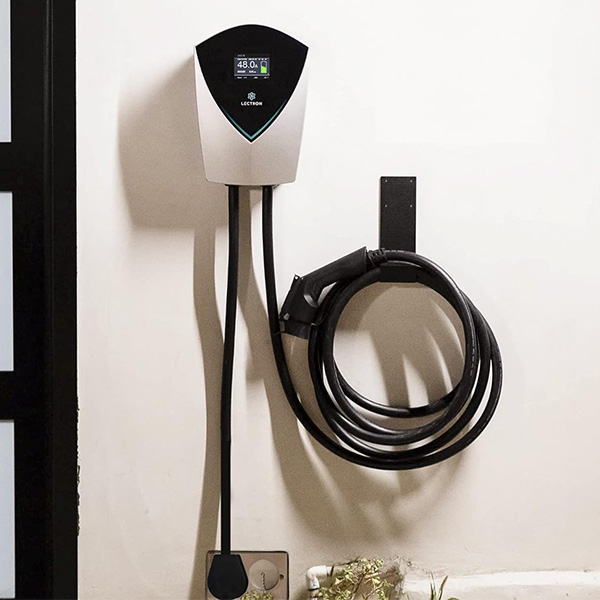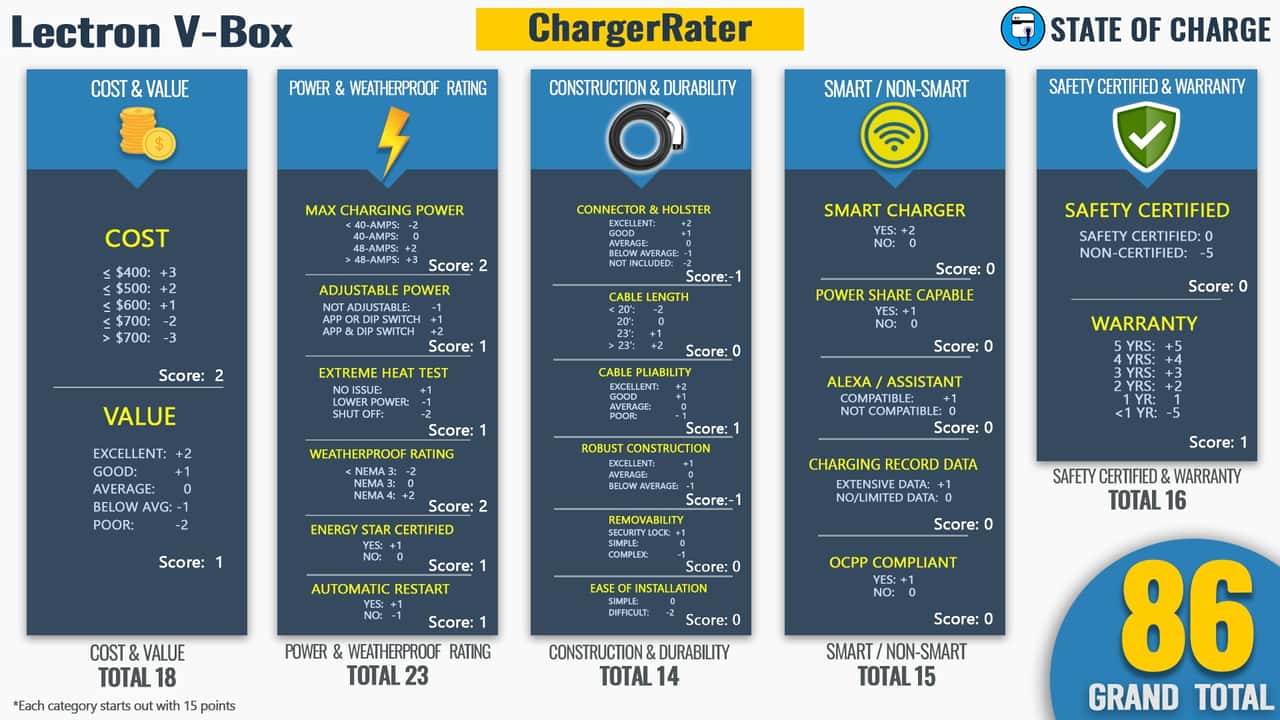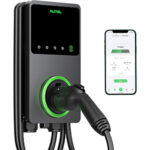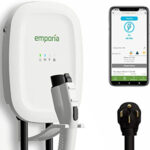State of Charge
Charging Station Reviews
We independently review every item we recommend. If you buy through our links, we may earn a small commission that helps us continue to make quality content for you. Thanks for your support!
Lectron V-Box EV Charging Station Review
Is this the right charger for your needs?
Table of Contents:
Lectron is no stranger in the electric vehicle charging industry– this Minnesota-based company offers a wide variety of electric vehicle adapters, extension cables, circuit splitters, portable chargers, and other high-powered wall-mounted EV charging hardware.
The company sent me a sample of its most powerful charger, the hardwired 48-amp V-Box, so that I could try it for a couple of weeks and provide consumers with a comprehensive review. Here's what I discovered during my use.
Key Specs of the Lectron V-Box
The Lectron V-Box arrived in a compact box holding the unit's body with an attached mounting bracket, a 20-foot charging cable with a J1772 connector (though a NACS connector is available as well), a 2-piece remote connector holster, user's manual and installation guide, mounting template, screws, drywall anchors, and screw caps. Honestly, I felt that the provided screws were small and inadequate for keeping an expensive electronic device mounted with regular use, and I'd suggest swapping them for something heavier-duty. The screw caps are particularly important if you are mounting the unit outdoors, in order to keep the elements from creeping into the body of the unit and damaging it.
The Lectron V-Box can be used from 16 to 40 amps with a NEMA 14-50 plug, but if you want to use it to its maximum potential, you'll want to hardwire this unit to get the full 48 amps. I always suggest that folks have hardwired charging stations professionally installed to reduce the chance of a dangerous electrical failure. I personally recommend my YouTube channel sponsor Qmerit for the installation of EV charging equipment. As North America’s leading provider of installation services for EV charging, home energy storage, and other electrification technologies, you can count on them to get the job done right.
But if you're planning on using the Lectron V-Box at a lower power level or want to handle the installation yourself, you can start out by removing the mounting bracket from the back of the unit, using the included mounting template to drill along a stud (for extra stability), and mount the bracket on the wall. Then you'll need to set your amperage by taking a small cover off of the back of the body of the unit to reveal a wheel that can be turned to adjust the power output. Once that's done, reinstall the unit on the mounting plate, tighten up the screws, and install the screw caps over the holes in the side of the unit. All that's left at that point is to install the remote connection holster and plug the unit in.
I did run into a few things I didn't like during this process. First off, I was not impressed with the unit's build quality– the cover felt really thin and bendable, the interior rubber gasket meant to protect the interior from the elements seemed really wimpy, and I felt that overall the production was on the low end. Secondly, I didn't like that Lectron ships you the unit with the NEMA 14-50 plug while the unit is automatically set to deliver 48 amps. I think it should come factory set to 40 amps instead, since that's what the attached cable can deliver. Otherwise, the Lectron V-Box can overdraw your circuit and trip your circuit breaker when you use it.
The Lectron V-Box is a 48-amp EVSE that can put out up to 11.5 kW of power at a variable 16 to 48-amp rate. It can be ordered with either a J1772 or a Tesla North American Charging Standard (NACS) connector, depending on your needs. Its 20-foot cable should be good enough for most users, and thanks to the included remote charging holster, it can be installed wherever is most convenient for you.
Since the V-Box isn't a smart charger, it doesn't come with an affiliated WiFi-connected app. However, it does come with a convenient 2.75" x 2" display screen that can show you helpful information like the current power draw, elapsed time of the charging session, line voltage, kWh dispensed, the power output limit, and the internal temperature. The housing is rated as IP55, which is a NEMA 4 equivalent, which makes it a good choice for outdoor installations that need protection from blowing rain, snow, and dust. The Lectron V-Box is also ETL safety certified and Energy-Star certified, and comes with a one-year warranty that can be upgraded at an additional cost.
Testing
A huge part of my reviews center around testing– putting each EV charging unit through my own rigorous testing procedures that simulate situations you may experience during the course of everyday use. Why? Because EV charging stations aren't cheap, and the last thing you want to do is drop a few hundred bucks on a unit that fails or doesn't meet your needs. I put them through their paces so you don't have to. So how did the Lectron V-Box do compared to other EVSEs?
The Cable Deep Freeze Test
My Cable Deep Freeze Test simulates extreme cold situations for the EV charging stations I test, allowing consumers to see how a unit's cables will handle frigid situations. It's not something everyone needs to think about, obviously, but an inflexible cable could make or break the charging experience of those mounting such a unit outdoors in more northern environments. The V-Box went into my commercial ice cream freezer for 24 hours before I measured the internal temperature at -13.5° F (-25.27° C). The charging cable started out coiled in small loops when I put it into the freezer, and to my surprise, the thick cable uncoiled fairly easily after I mounted the unit back on the wall. It did fight a little bit, but I could wind it back up and holster it without issue. It's not quite as flexible as the ChargePoint Home Flex, but I certainly don't have a problem recommending it for cold weather use.
The Connector Drop Test
While the connector is still frosty, I moved on to the Drop Test, where I test a connector's durability by dropping it five times from around waist height to the concrete floor of my garage. I actually waited until I was nearly done with my review for this unit to complete this test, because I was very concerned that the connector would not pass– it just didn't feel that solid to me. But the connector held up well and proved me wrong, coming away from the test with a little damage to the outer edge of the connector's plastic but otherwise fine. That's a pass from me.
The Extreme Heat Test
In contrast with the Cable Deep Freeze Test, the Extreme Heat test lets users see how a unit will charge when installed in extremely hot temperatures. I put a heat lamp in front of the Lectron V-Box for two hours until the internal temperature of the unit reached 124° F (51.1° C). Then I plugged it into an EV drawing maximum power (40 amps in this case) for another 2 hours with the heat lamp still on. The temperature climbed in excess of 175° F (79.4° C) while my EV continued charging without any issues, but the display on the V-Box went black and I actually thought I'd melted and burned the screen out. However, after removing the heat lamp, the display quickly began to reappear. Another thing I noticed was that the plastic front casing of the unit had warped due to the heat. These issues led me to believe that the Lectron V-Box may not be the best choice for outdoor use in hotter climates, though it does pass my Extreme Heat Test.
The Automatic Restart Test
Imagine going through a temporary power outage and finding out the next morning that your EV never resumed charging after the power resumed. Frustrating, right? These days, most EVSEs are supposed to resume a charging cycle as soon as power is restored, but the feature doesn't always work. I simulated a power outage with the Lectron V-Box while charging my Chevrolet Bolt EV, and the unit had no issues re-engaging after the power came back on. That's a pass on the Automatic Restart Test.
Since not everything can be easily measured on a chart, I also like to give the charging stations I review my own personal score. I gave the Lectron V-Box a rating of 4.1 stars out of 5, mainly because I'd like to see the cable come a little longer and the overall unit upgraded in terms of production quality. After averaging the ChargerRater score with my own, I gave the Lectron V-Box a final score of 4.2 stars. It's a good product and one I'm comfortable recommending, but it does have some shortcomings.
The Lectron V-Box is currently available for $379.99 on Lectron's website (as of April 9, 2024). Check out the video above for my comprehensive review, and let me know your thoughts in the comments below.

By: Tom Moloughney
YOU MIGHT ALSO BE INTERESTED IN:


EVChargingStation’s Comment Policy
We welcome polite, respectful comments, but rudeness and personal attacks will not be tolerated. All comments are reviewed prior to publication. Thanks for joining in the conversation!










0 Comments